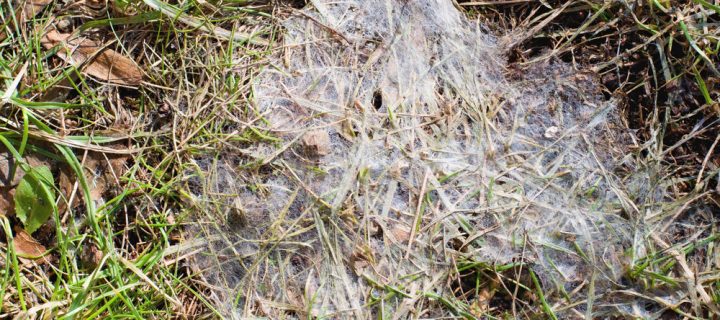Snow mold develops on the ground in fall and comes back to life in spring.
Spring is here, or at least around the corner in some parts. If it’s still snowing outside your window this wintery weather is sure to stop someday soon. If it already has, thoughts of getting your garden ready for growing may be circulating in your head, bringing forth ideas for summer. Sounds like fun! With allergy season at least a month or more away, you’re free to muck about sneeze-free outside as you clear away any remaining brush and branches to ready your gardens and grass for warmers day, right?
In most cases, yes, this would be correct. But depending on where you live, if you suffer from a sensitivity to mold, you might want to wait. You could find yourself sneezing up a storm even though not much has started to grow back yet, (if you’re in a northerly climate).
Sure, you could have a cold. Or the coronavirus. Or, perhaps you’re allergic to your neighbor’s dog. But it could actually be an allergy to something you may have never heard before: snow mold.
What is snow mold and what can you do about it? Here’s a look.
What is snow mold?
Snow mold is a fungus that can be found in spring in grasses after the snow melts. This type of mold is typically found in regions that receive a large snow pack during winter such as the American midwest and the Canadian prairies.
Snow mold can actually thrive under deep snow. You only see it once the weather warms up and the snow begins to melt. The mold doesn’t start growing in spring, however. It actually begins propagating on the ground in fall and then as winter hits, the mold becomes covered in snowfall. When the ground freezes, snow mold doesn’t die out but lies dormant. Once the spring thaw arrives, the mold reawakens in the newly wet soil, sending its spores flying around into the surrounding air.
Related: 3 Best Exercises to Fight Incontinence
How can you spot it? This mold looks like a feathery, cotton-like substance in grass and can be mistaken for small bits of snow that haven’t yet melted, from further away.
The mold eventually does disappear with time but it can damage your lawn leaving patchy areas, and can cause allergies in those who are susceptible. It can also trigger asthma attacks.
What are the symptoms of snow mold allergies?
As with many seasonal allergies, snow mold allergy symptoms include your typical runny nose, itchy eyes, and sneezing. Taking an antihistamine medication can help.
How can you prevent snow mold from growing?
Raking up all those leaves in fall may seem like a lot of work but if you’re allergy-prone, it can be worth it. Snow mold loves longer grass and wet piles of leaves that can provide a moist home for growth.
To limit your chances of developing snow mold problems around your property, make sure you rake up your leaves in fall. Next, cut your grass shorter for its last cut before winter. If you do develop pesky snow mold, rest assured that a good, solid rainfall in spring is likely to wash it all away.
photo credits: Tunatura/Shutterstock.com












